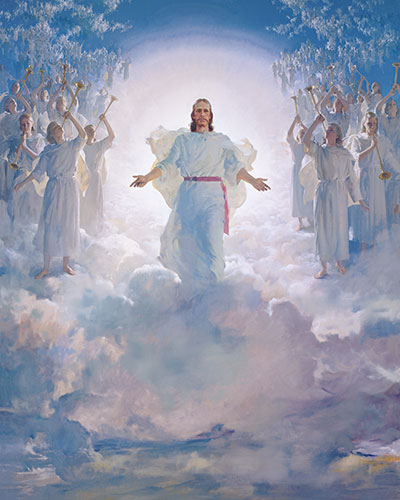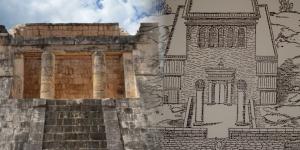You are here
Why is There Temple Imagery in Helaman 10?

Helaman 10:8
The Know
In Helaman 10, after revealing the murderer of the chief judge, Nephi the son of Helaman began to walk back to his house, pondering upon the wickedness of the people. As he was thinking about all that had just transpired, God reassured Nephi that his diligence did not go unnoticed (v. 3–5). Suddenly, God stated that His words to Nephi were being given “in the presence of [God’s] angels” (v. 6), and then it appears that God’s declaration to Nephi was being given in a temple (“if ye shall say unto this temple,” v. 8). These somewhat unexpected and often overlooked details suggest that Nephi was being shown a vision of the divine council inside a holy temple.
In ancient Israel, some prophets received visions in which they saw God’s “divine council,” a group composed of God and His “royal court” in heaven.1 Accounts of these experiences have similar elements: the prophet has a pressing need for help, often related to knowing how to help a wicked group of people.2 The prophet is in a temple or mountain setting.3 He sees the divine council, or a messenger from the council.4 The Lord reassures him and gives him knowledge.5 He is then empowered and called to speak and act on God’s behalf.6
Over the years, several LDS biblical scholars have noted continuities between these Israelite throne manifestations and the revelatory experiences of Book of Mormon prophets.7 Recently, David Bokovoy, one such LDS biblical scholar, explained that elements like these “provide a type of template for depicting an official encounter between witness and worshipper in preparation for the introduction to advanced revelatory truths.”8
Isaiah 6 is a good example of what this template looks like, as Stephen Ricks has carefully explained.9 Isaiah said that he, “saw ... the Lord sitting upon a throne … [in] the temple” (v. 1). God was surrounded by seraphs, which are heavenly beings (v. 2). This follows the pattern of seeing the divine council in a temple or mountain setting.10 Isaiah was concerned with knowing how to help the people be less wicked, saying that he lived “in the midst of a people of unclean lips” (v. 5). The Lord symbolically cleansed him and reassured him by telling him that his “iniquity [was] taken away” (v. 7). The Lord gave him information that some people would not be able to understand (v. 10). God also told him to “go, and tell this people” (v. 9).
Father Lehi had an experience very similar to this, as did his son Nephi.11 In Nephi’s case, the divine council experience in 1 Nephi 11 contains a detail that helps explain Helaman 10. It began as Nephi was “pondering” Lehi’s account of his dream in his “heart” (1 Nephi 11:1). Nephi was then spiritually transported to a high mountain where he had his divine council experience.12 The only other time something happened in the Book of Mormon as a character was “pondering” in his “heart,” was the experience of this later Nephi, in Helaman 10:3.13 According to the ancient Israelite writing style that Book of Mormon authors likely employed, this detail was a signal to the reader to read Helaman 10 in conjunction with and comparison to 1 Nephi 11.14
This comparison indicates that the experience of Nephi, the son of Helaman, in Helaman chapter 10 is yet another example of the sacred divine council experience. Nephi needed help, and was “pondering” how he could help eliminate “the wickedness of the people” (v. 3). He then found himself at a “temple” (v. 8) on a “mountain” (v. 9). Angels were present (v. 6). The Lord reassured him by telling him that he was “blessed” because he had been keeping God’s commandments (v. 4). God gave him religious truths and empowered him with the ability to “seal” and “loose” on “earth” and in “heaven” (v. 7). Finally, Nephi was called to speak and act on God’s behalf, being told to “go and declare” God’s words to the people (v. 11).
The Why
Seeing Nephi the son of Helaman as being admitted into the presence of the divine council explains the presence of angels, temples, mountains, and sealing in Helaman 10. As the leading Nephite prophet and high priest Nephi would have been familiar with the Israelite temple traditions, having officiated over the main temple in Zarahemla, the temple King Benjamin, Mosiah, Alma, and Helaman used.
Moreover, Nephi was “much cast down because of the wickedness of the people of the Nephites” (Helaman 10:3). Considering that he had narrowly escaped being put to death and that the Gadianton robbers had killed the chief judge, his great concern and need for divine guidance and reassurance was certainly a reasonable response.
Yet it was during this difficult time of personal obedience and sacrifice that Nephi not only heard God’s voice (Helaman 10:3) but had an expansive prophetic experience with the Lord and His heavenly host. Nephi’s profound story reminds readers that sometimes the most spiritual experiences only come after the most painful experiences.
Joseph B. Wirthlin stated, referring to Christ’s crucifixion,
Each of us will have our own Fridays—those days when the universe itself seems shattered and the shards of our world lie littered about us in pieces. We all will experience those broken times when it seems we can never be put together again. We will all have our Fridays. But I testify to you in the name of the One who conquered death—Sunday will come. In the darkness of our sorrow, Sunday will come. No matter our desperation, no matter our grief, Sunday will come. In this life or the next, Sunday will come.
During what may have been one of Nephi’s darkest moments, God blessed Nephi, who swore an oath to Nephi in His own name that He would always be with him and answer his prayers.15 This is a powerful reminder of God’s personal care and covenantal reassurance in the darkest of times. This principle is as true for readers of the Book of Mormon today as it was for Nephi the son of Helaman shortly before the birth of Christ.
Further Reading
Stephen O. Smoot, "The Divine Council in the Hebrew Bible and the Book of Mormon," Studia Antiqua: A Student Journal for the Study of the Ancient World 12, no. 2 (Fall 2013): 1–18.
David E. Bokovoy, “‘Thou Knowest That I Believe’: Invoking The Spirit of the Lord as Council Witness in 1 Nephi 11,” Interpreter: A Journal of Mormon Scripture 1 (2012): 1–23.
Taylor Halverson, “The Path of Angels: A Biblical Pattern for the Role of Angels in Physical Salvation,” The Gospel of Jesus Christ in the Old Testament, The 38th Annual BYU Sidney B. Sperry Symposium (Provo, UT: Religioius Studies Center, Brigham Youngg University, 2009).
Stephen D. Ricks, "Heavenly Visions and Prophetic Calls in Isaiah 6 (2 Nephi 16), the Book of Mormon, and the Revelation of John," in Isaiah in the Book of Mormon, ed. Donald W. Parry and John W. Welch (Provo, UT: FARMS, 1998), 171–190.
Andrew C. Skinner, “Nephi’s Ultimate Encounter with Deity: Some Thoughts on Helaman 10,” in The Book of Mormon: Helaman through 3 Nephi 8, According to Thy Word, ed. Monte S. Nyman and Charles D. Tate Jr. (Provo, UT: Religious Studies Center, Brigham Young University, 1992), 115–127.
- 1. See Book of Mormon Central “How Did God Call His Prophets in Ancient Times? (1 Nephi 15:8),” KnoWhy 17 (January 22, 2016).
- 2. Genesis 14:11; 1 Samuel 7:5-9; Jeremiah 14:11; Isaiah 6:5.
- 3. Isaiah 6:1. It is possible that the experience of Moses in Exodus 19–20 was similar to this as well. See also Joel S. Baden, The Composition of the Pentateuch: Renewing the Documentary Hypothesis (New Haven, CT: Yale University Press, 2012), 118.
- 4. 1 Kings 22:19-23; Jeremiah 23:18.
- 5. Ezekiel 2:10; Isaiah 6:5.
- 6. Isaiah 6:1-13; Amos 3:7; Habakkuk 2:2.
- 7. For example, in the 1986 FARMS newsletter, see John W. Welch, “Lehi’s Council Vision and the Mysteries of God,” reprinted in Reexploring the Book of Mormon (Provo: FARMS and Deseret Book, 1992), 24–25.
- 8. David E. Bokovoy, “‘Thou Knowest That I Believe’: Invoking The Spirit of the Lord as Council Witness in 1 Nephi 11,” Interpreter: A Journal of Mormon Scripture 1 (2012): 17.
- 9. See Stephen D. Ricks, “Heavenly Visions and Prophetic Calls in Isaiah 6 (2 Nephi 16), the Book of Mormon, and the Revelation of John,” in Isaiah in the Book of Mormon, ed. Donald W. Parry and John W. Welch (Provo, UT: FARMS, 1998), 175–181; David E. Bokovoy, “On Christ and Covenants: An LDS Reading of Isaiah’s Prophetic Call,” Studies in the Bible and Antiquity 3 (2011): 29–49.
- 10. In this case both requirements are met because the temple of Solomon was on a mountain.
- 11. John W. Welch, “The Calling of Lehi as a Prophet in the World of Jerusalem,” in Glimpses of Lehi’s Jerusalem, ed. John W. Welch, David Rolph Seely, and Jo Ann H. Seely (Provo, UT: FARMS, 2004), 421–448; Kevin L. Tolley, “To ‘See and Hear’,” Interpreter: A Journal of Mormon Scripture 18 (2016): 139–147.
- 12. Bokovoy, “‘Thou Knowest That I Believe’,” 22.
- 13. For another example of the significance of rare phrases, see Book of Mormon Central “Why Was Helaman’s Servant Justified In Killing Kishkumen?,” KnoWhy 173 (August 25, 2016).
- 14. John E. Harvey, Retelling the Torah: The Deuteronomistic Historian’s Use of Tetrateuchal Narratives, JSOTSup 403 (New York, NY: T&T Clark, 2004), 61.
- 15. Compare 1 Nephi, where Nephi swears by God and himself (1 Nephi 4:32), but God just swears by himself, as He sometimes does. See, for example, Genesis 22:16; Isaiah 45:23; Jeremiah 22:5; Amos 8:7. God swears by himself because there is no other higher authority by which he can make an oath and covenant; see Hebrews 6:13.
KnoWhy Citation
Related KnoWhys
Subscribe
Get the latest updates on Book of Mormon topics and research for free







